Streamlining a sales and contracting pipeline is crucial for any business.
While there are multiple steps to this process, e-signing and document management platforms like Proposify and DocuSign have a role to play.
But, while both of the platforms aim to enhance your business process, they go about it in very different ways.
Proposify, a dedicated proposal software, aims to empower teams with document creation tools, in-depth analytics, and customizable templates.
DocuSign, on the other hand, is a well-established giant in the e-signing space.
This platform offers a comprehensive suite of tools for document management and e-signature capture.
In this comparison, we’ll dive deeper into the features, pricing, and value that both of these platforms can offer.
Let’s get started.
Key takeaways
- Proposify is equipped to handle more of your sales and document workflow. Electronic signatures are only a small part of what the platform can handle.
- DocuSign is focused primarily on the e-signature process and offers a limited selection of tools to facilitate document design and pipeline management.
- Both tools offer similar features, including audit trails, automation options, digital signature functionality, and other tools. Due to this overlap, you’re unlikely to need both platforms.
Proposify
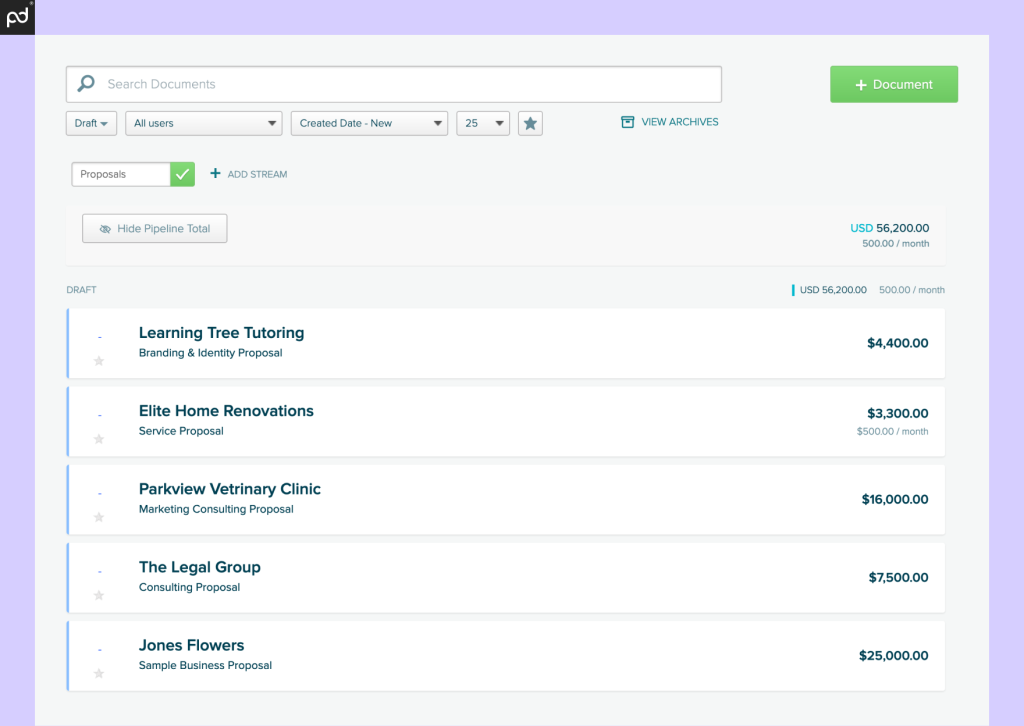
Pricing: Team ($49). Enterprise pricing also available. Pricing only available via month-to-month commitment.
Ease of use: 8.3/10
Free trial: Yes; 14 days.
Support: Knowledge base; support tickets; phone.
Designed to streamline and enhance the sales process, Proposify aims to help users create and send business proposals faster than ever before.
The platform features a robust proposal creation tool (similar to our own document editor).
Users can convert pre-created proposal templates or build new proposals entirely from scratch using onboard formatting features before dispatching them for electronic signature.
Teams will also have access to powerful template customizations, pricing tables, and an arsenal of content management solutions.
With Proposify, it’s even possible for users to consolidate their entire proposal management and deals processes into a single platform.
Once finalized, proposals created inside the onboard editor can be dispatched to signers for quick and easy e-signature capture.
Senders can also monitor document analytics and use those metrics to improve future proposals.
At $50 per month with no annual commitment and no transaction limits, Proposify is a great fit for freelancers, small businesses, and enterprise teams who want to keep their proposal process all in one place.
DocuSign
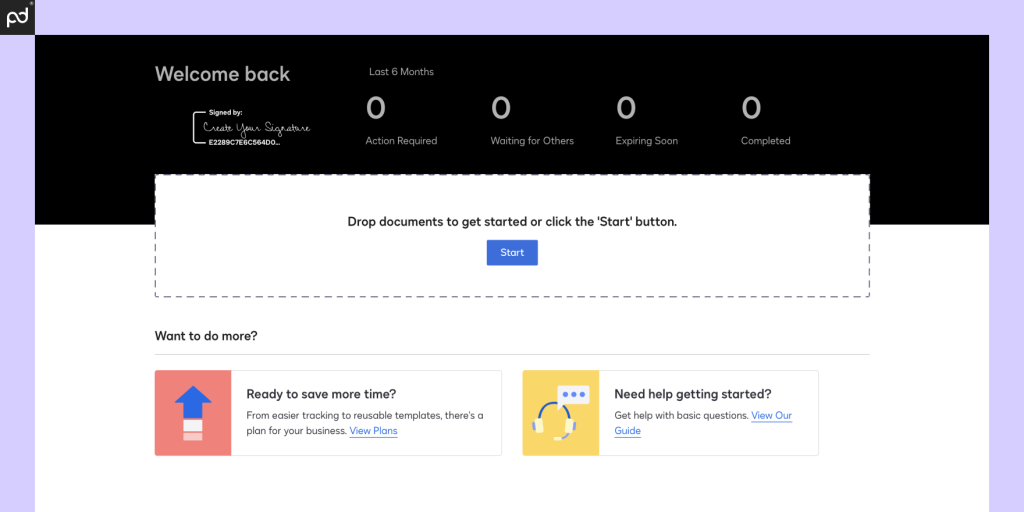
Pricing: Personal ($15); Standard ($45); Business Pro ($60). Enterprise pricing available. All pricing based on month-to-month commitment.
Ease of use: 9.0/10
Free trial: Yes; 30 days.
Support: Knowledge base; support tickets; additional support plans sold as separate packages.
An industry leader in the e-signature space, DocuSign is focused primarily on facilitating the digital signing process between senders and signers.
This platform offers an e-signature solution alongside a limited selection of drag-and-drop document preparation tools.
DocuSign also places heavy emphasis on information security and signature validity, taking steps to ensure compliance with global e-signature laws.
However, beyond those basic features, DocuSign offers automation to streamline many document processes.
From template creation and payment capture to robust integration options, teams big and small count DocuSign as a tried-and-true e-signature tool.
For users who want to go beyond simple e-signature, DocuSign also offers a variety of document generation and management solutions.
However, these solutions are part of the larger DocuSign ecosystem and aren’t included in the standard e-signing plans.
Proposify vs DocuSign at a glance
Ready for a closer look at how Proposify and DocuSign measure up?
We’ll cover everything in greater detail below, but here’s a direct comparison between a similar set of plans offered by both organizations.
| Plan Details | DocuSign | Proposify |
|---|---|---|
| Plan Name | Standard | Team |
| Core product | ||
| E-signature capture | ✓ | ✓ |
| Real-time audit trail | ✓ | ✓ |
| Notifications | ✓ | ✓ |
| Language support | ✓ | ✓ |
| Mobile app | ✓ | ✓ |
| Reporting tools | ✓ | ✓ |
| E-signing features | ||
| Signing order | ✓ | X |
| Send to multiple recipients | ✓ | ✓ |
| Bulk send | X | X |
| In-person signing | ✓ | X |
| Collaboration tools | ✓ | X |
| Signer attachments | X | X |
| Payment gateway | X | ✓ |
| Document prep | ||
| Drag & drop fields (PDF) | ✓ | ✓ |
| Create reusable templates | ✓ | ✓ |
| From-scratch document builder | X | ✓ |
| Pre-built template library | X | ✓ |
| Form creation | X | X |
| Custom branding | ✓ | ✓ |
| Integrations & API | ||
| Import & storage | ✓ | X |
| CRM | X | Limited |
| Productivity | ✓ | Limited |
| API | $ | X |
| Support | ||
| Email / ticketing support | ✓ | ✓ |
| Chat support | X | ✓ |
| Knowledge base | ✓ | ✓ |
| Phone | X | X |
| Premium support options | $ | X |
In the chart above, we’ve compared Proposify’s only packaged plan (Team) with DocuSign’s midrange plan (Standard).
These plans are similar in price, on a month-to-month basis, but users veering toward DocuSign may consider switching to an annual plan for substantial savings.
With that in mind, other plans are also available:
- DocuSign offers a more expansive Business Pro plan $65/month (monthly) or $40/month (annual) per user. Enterprise plans are also available.
- Proposify’s next step is the enterprise-level Business plan. This plan offers additional functionality around customer support and user roles but requires custom pricing.
As you might expect, upgraded plans offer a broader range of options and functionality. Proposify users won’t have as far to go to unlock all platform features since only one upgrade is required.
To get access to all features, DocuSign users will need to upgrade past Business Pro to the enterprise solution, signaling a substantial increase in costs (full breakdown here).
One final consideration is transaction limits.
- DocuSign limits users to 100 envelopes per user/year.
- Proposify doesn’t cap usage or limit transactions.
DocuSign’s envelopes restrict how many times you can use the service to send signature-ready documents over the course of a year.
Whether you send documents individually or bundled together, the platform will only allow for 100 total sends within the scope of a regular plan.
Enterprise plans may have higher negotiated rates, but those will come at a cost.
This is problematic for users in key positions like sales and HR, who often need to send a high volume of documents.
Once the cap is reached, the send limit will need to be raised by the sales team, incurring additional plan fees.
Note that sent documents, even if never opened or signed, also count against this limit.
Proposify, like PandaDoc, doesn’t place a limit on the number of documents users can send.
This is a key advantage for sales teams, since reps can broaden their sales pipeline without needing to worry about signing limits.
Requirements, workflows & pricing
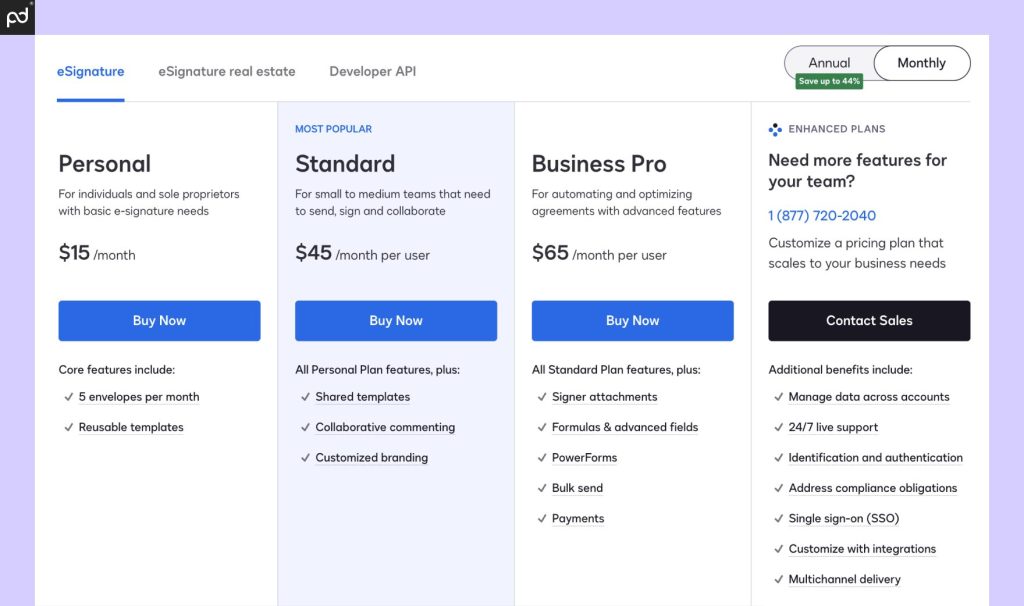
While both Proposify and DocuSign offer electronic signature software as part of their technology solution, the use case for each tool is very different.
DocuSign is an e-signing solution designed to help users capture digital signatures for their documents.
This platform comes into play at the end of a document process.
By that time, documents have been created using word processors and/or design software and simply need to be signed by all parties to ensure legal validity.
Focusing purely on this end-of-flow process means that DocuSign can seamlessly attach itself to most workflows, regardless of their industry or use case.
Sales, human resources, legal, and other departments can finalize necessary documents, upload them to DocuSign, prepare them for signature, and send them to all appropriate parties.
This versatility means that DocuSign and other e-signing platforms that emphasize this process offer greater scalability than more complex software tools.

On the other hand, Proposify angles to facilitate a much larger share of the proposal creation process.
Using Proposify, sales teams can create digital proposals from scratch with the built-in drag and drop editor and push those docs through approved workflows before distributing them to potential customers.
This is a key difference between Proposify and DocuSign.
Where DocuSign users will need to design all documentation using off-platform tools, Proposify users will do this inside the platform.
While this can allow Proposify to handle a larger share of the document process, the software only does so within a relatively narrow scope.
As the brand name suggests: Proposify is built (primarily) for sales proposals.
It’s also possible to construct contracts and quotes with the platform, but its use case narrows considerably outside sales enablement processes.
Unfortunately, Proposify doesn’t allow users to import existing document files with ease — unlike PandaDoc, which supports imports for a variety of file types.
Users will need to rebuild all existing proposals and contracts inside the Proposify platform to achieve full functionality.
Our suggestion
Depending on your use case, both DocuSign and Proposify may be viable e-signing platforms.
Ultimately, the right choice will come down to how you currently handle document creation and whether sales proposals and contracts play a role in your daily operations.
If that’s the case, proposal platforms like Proposify or PandaDoc can create a more seamless experience by providing project management and approval workflows to your sales process.
However, if you don’t need any of those extras, DocuSign’s streamlined preparation and e-signing focus may be a better fit.
- DocuSign will make the most sense for teams who only need an e-signing process and are happy with their existing document creation workflow.
- Proposify is a better fit for teams who want to consolidate proposal creation and e-signing into a single platform and are willing to make that transition.
- PandaDoc offers similar functionality to Proposify but provides upload support for existing DOCX files, removing the need to rebuild existing proposals and contracts entirely from scratch.
Document preparation & design
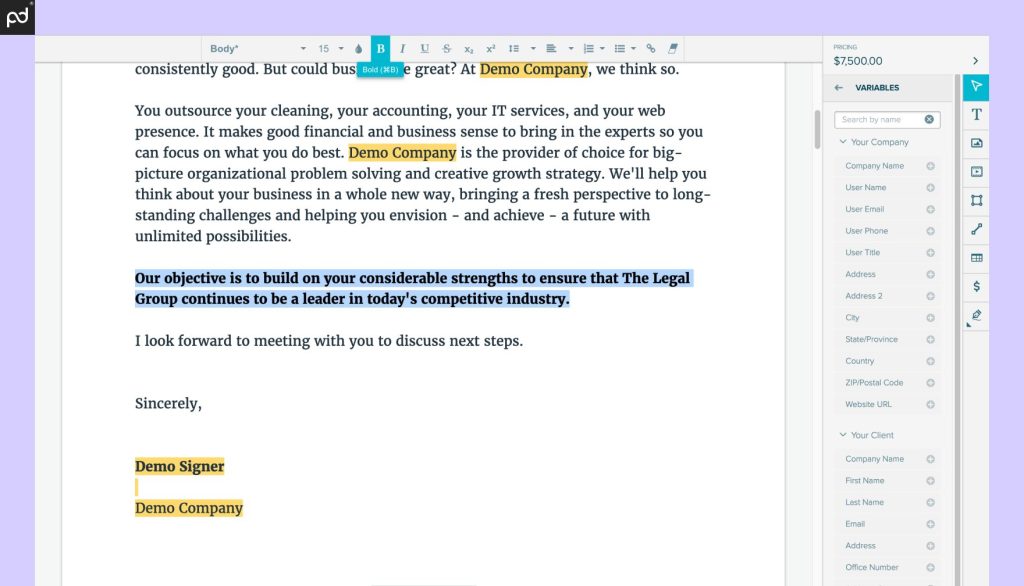
While both DocuSign and Proposify enable e-signature capture, documents moving through both platforms will need to be prepared prior to sending.
Because Proposify offers full document creation, their process is far more complex.
Users will need to build their entire document from scratch using the Proposify editor.
This includes adding paragraphs, images, and other multimedia elements.
Strictly speaking, it’s possible to upload PDF copies of existing documents, but they won’t be editable in the Proposify editor (which defeats the purpose of the platform).
As part of the document creation process, creators can add pricing tables, e-signing boxes, payment modules, and other functionality to prompt sign-offs and approvals with prospective clients.
While this might sound like a ton of work (it is!), savvy document creators will take advantage of Proposify’s content library and document template tools in order to vastly increase future creation flows.
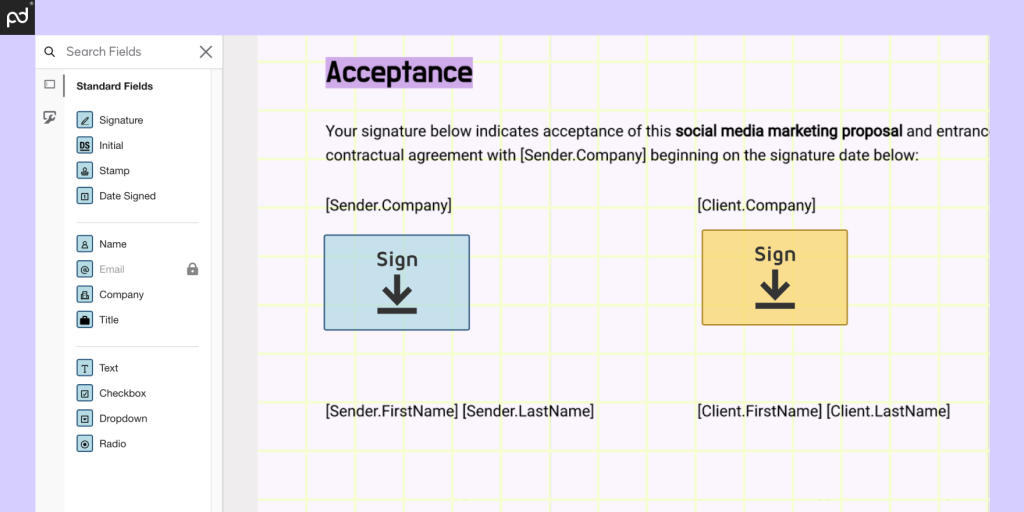
When compared to Proposify, DocuSign’s solution is far simpler.
Users will upload any document for digital signature.
DocuSign will convert the file to a PDF, which locks the documents and prevents any major editing initiatives.
Using drag-and-drop tools, preparers can add blocks for e-signing and other basic information (name, date, etc.) before dispatching the document to intended recipients.
Additional features like approval workflows and payment processing are also available.
While this process is far simpler than Proposify, keep in mind that DocuSign’s preparation process removes the ability to edit and refine documents.
Any substantial corrections that need to be made will require users to pull documents back into dedicated editing software for revision.
It’s also possible to create templates within DocuSign after editing is complete, but DocuSign lacks the ability to create snippets and modular templates like those you’ll see in Proposify or PandaDoc.
Our suggestion
The document preparation processes for both DocuSign and Proposify are linked to the use case for each platform.
Similar to PandaDoc, Proposify offers a greater selection of design tools because its intended purpose is to handle all aspects of proposal creation.
If you’re planning to use Proposify for e-signing, approaching the platform as both a design and digital signature software is the best approach.
DocuSign has more versatility in this regard, since their drag-and-drop tools can be used to handle any document.
In exchange, the platform locks any uploaded documents to a PDF format and makes them uneditable.
To make changes, users will need to make corrections in the original creation software and upload the new revision.
- DocuSign’s preparation flow is simpler and more limiting, but it’s also easier for new users to grasp and requires no major onboarding.
- Proposify’s process is much longer and more open-ended because users need to build documents entirely from scratch, but the platform offers much better control.
Integrations & connectors
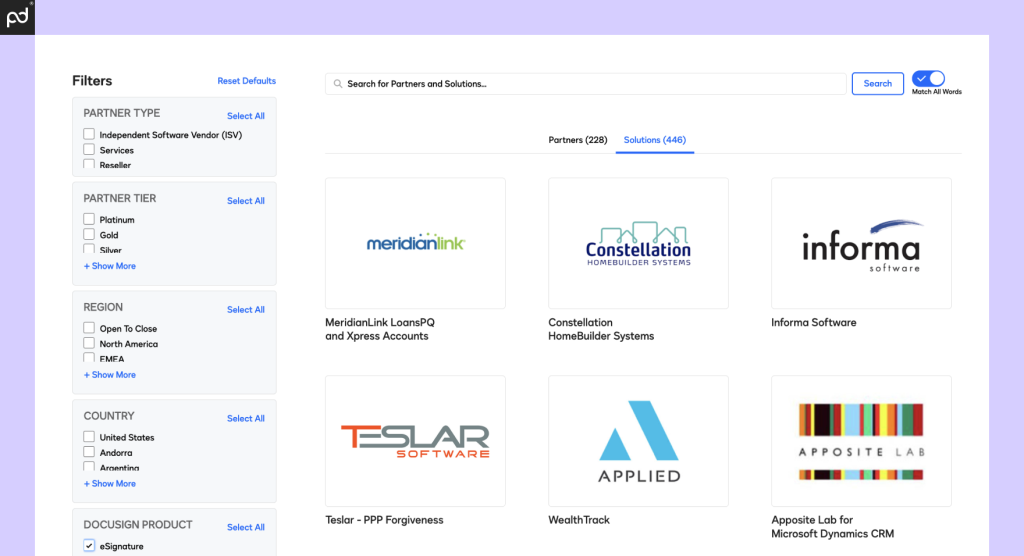
Even though it’s possible for most e-signing platforms to operate independently, the ability to integrate with an existing tech stack is highly prized by most organizations.
Both Docusign and Proposify provide connectivity options in some capacity, but they do so in different ways.
It’s not an exaggeration to say that DocuSign is the king of integrations in the e-signing space. The platform offers nearly 600 partner integrations, and most are available regardless of your plan choice.
DocuSign’s integration library includes connectors for very niche and obscure software solutions, most of which won’t be available on other platforms (although it may be possible to replicate this functionality with API tools).
Users in search of a turnkey integration are most likely to find it here.
However, not all of DocuSign’s connectors are available to all users.
The company specifically reserves integrations for Salesforce, Microsoft Dynamics, and Netsuite for its enterprise suite.
Users with these tools should expect higher costs and a more expansive plan.
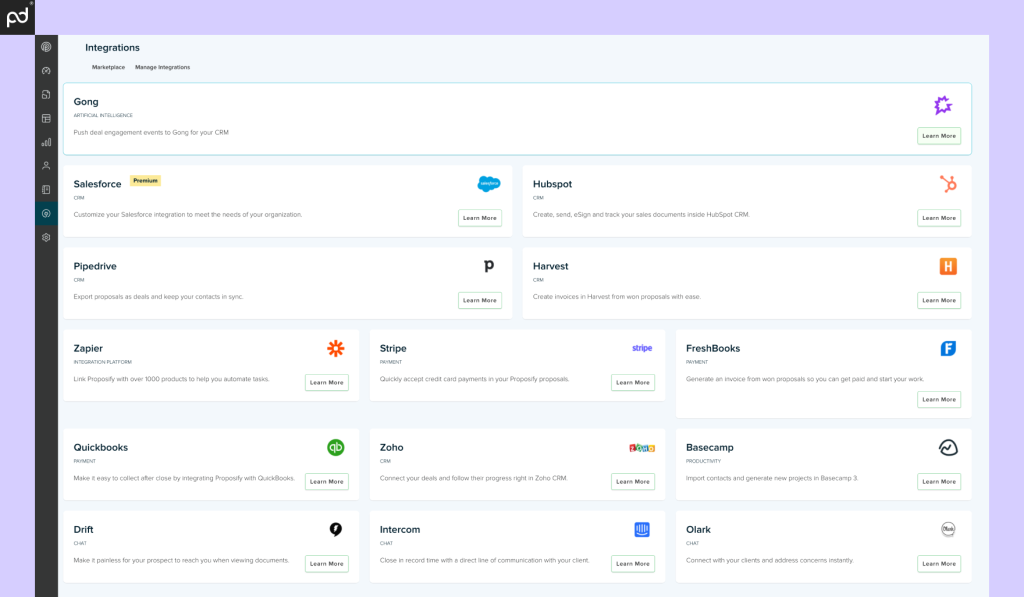
Proposify comes with a more limited selection of integration options.
Most of the platform’s CRM integrations (HubSpot, Zoho, Basecamp, etc.) are available on the Team plan, but Salesforce is exclusive to the Business plan.
Zapier integrations also play a major role for Proposify by allowing the software to integrate with productivity tools and apps outside of its native integration options.
However, you won’t see integrations for storage options like Google Drive or Dropbox with Proposify.
Unlike DocuSign, PandaDoc, and many other competitors, Proposify lacks the ability to upload and export files easily.
While it’s possible to download documents as PDFs, Proposify anticipates that most documents created and signed on the platform will remain there.
Our suggestion
Integrations are essential for teams who want to optimize their sales workflows because they allow for a seamless exchange of information between two separate platforms.
For example, PandaDoc users with the Salesforce integration can utilize all customer data within Salesforce to fill in document variables on a PandaDoc template with a few clicks.
However, all the Salesforce data remains with Salesforce, so teams can keep using processes and tools they prefer.
The same is true for Proposify and DocuSign. Integrations allow for a seamless handoff of information between CRMs, document storage apps, and productivity tools.
However, it’s important to remember that the only integrations that matter are the ones that work with your specific software setup.
If the apps lack an ability to connect, data can’t be easily exchanged.
- DocuSign offers the greatest selection of integration options, featuring 600+ connectors, but it reserves some of its most popular solutions for enterprise customers.
- Proposify offers a handful of native integrations but relies on Zapier to handle everything else. Import/export options are very limited with this platform.
- PandaDoc offers native integrations for most major CRM and productivity tools. Zapier and API functionality also offer an extendable framework for custom solutions.
Alternatives to Proposify & DocuSign
Both Proposify and DocuSign will be great fits for the right team, but they aren’t the only e-signing solutions on the market today.
Here are a few alternative options to consider:
- PandaDoc
- Dropbox Sign (formerly HelloSign)
- Adobe Acrobat Sign (formerly Adobe Sign)
- GetAccept
- SignRequest
Several modern e-signing solutions try to emulate DocuSign’s end-of-process strategy.
Many of these options provide similar functionality at a lower cost but lack the native integrations that DocuSign provides.
Proposify’s competitors are few and far between (full list here). PandaDoc and GetAccept are the main contenders.
Both offer in-app document editing, along with enhanced user controls and permissions.
Adobe Acrobat Sign offers native PDF editing, but it’s not a proposal management software and lacks many of the sales enablement features (messaging, deal rooms, etc.) that you’ll see in this category.
Try PandaDoc for better docs!
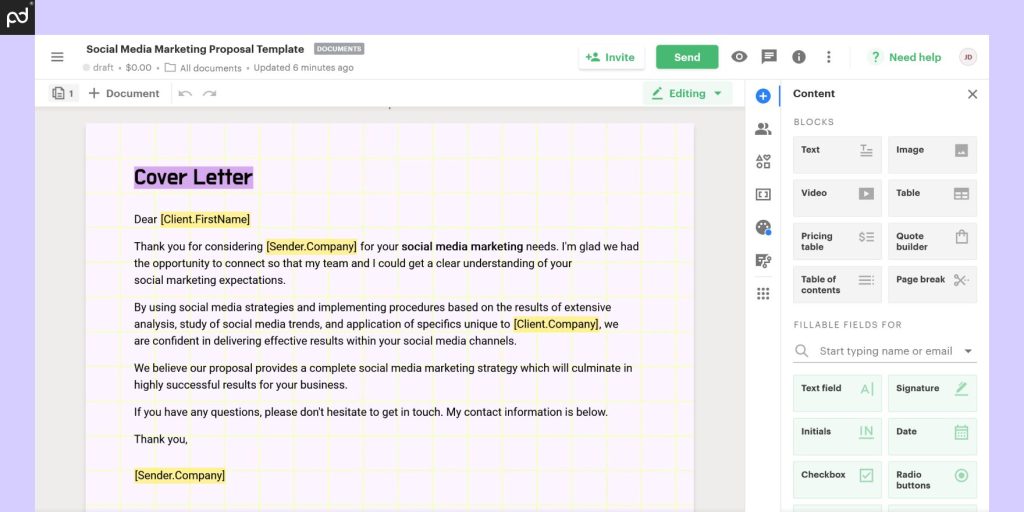
Deciding between Proposify and DocuSign for your business needs can be challenging, as both platforms offer valuable tools for different purposes.
Proposify focuses on streamlining the proposal process with its robust creation and tracking features, while DocuSign provides a more comprehensive suite of document management and e-signature solutions.
If you’re seeking a platform that combines the best of both worlds, consider PandaDoc.
Our all-in-one document creation and proposal management software offers a seamless experience for creating, managing, and signing proposals, contracts, and other essential documents.
Here’s why PandaDoc stands out as a compelling alternative:
- Intuitive proposal creation. Design visually appealing proposals with customizable templates, interactive pricing tables, and a user-friendly editor.
- Streamlined document workflows. Automate approvals, track document progress, and get legally binding e-signatures faster.
- In-depth analytics. Gain valuable insights into document engagement and performance to refine your sales strategies.
- Extensive integrations. Seamlessly connect PandaDoc with your CRM and other essential business tools for enhanced efficiency.
- Competitive pricing. Choose from flexible plans that cater to businesses of all sizes and budgets.
By bridging the gap between proposals, document management, and e-signing, PandaDoc offers a powerful solution for businesses seeking to enhance their entire document workflow.
Want to give it a try?
Sign up for a demo with our sales team or take PandaDoc for a test drive with a free 14-day trial.
Transform your document processes forever with PandaDoc!
Disclaimer
Parties other than PandaDoc may provide products, services, recommendations, or views on PandaDoc’s site (“Third Party Materials”). PandaDoc is not responsible for examining or evaluating such Third Party Materials, and does not provide any warranties relating to the Third Party Materials. Links to such Third Party Materials are for your convenience and does not constitute an endorsement of such Third Party Materials.
Originally published August 10, 2022, updated August 8, 2024


